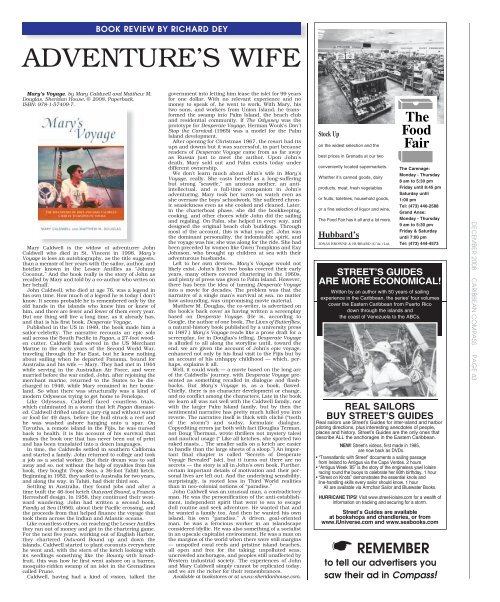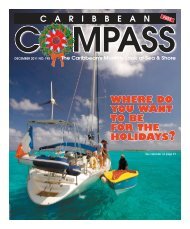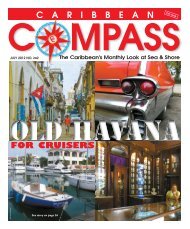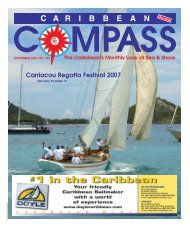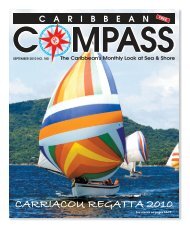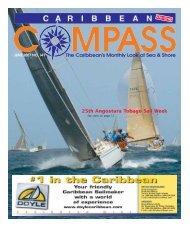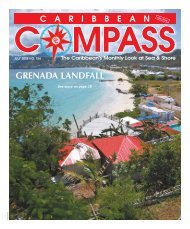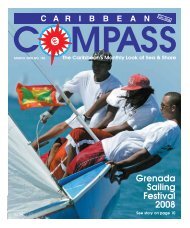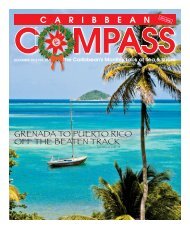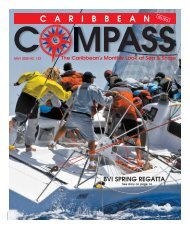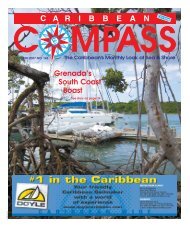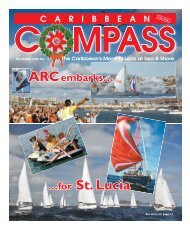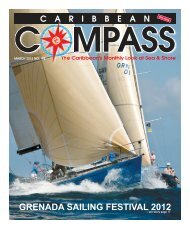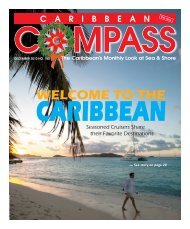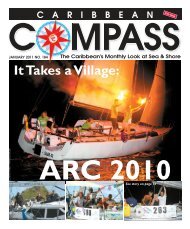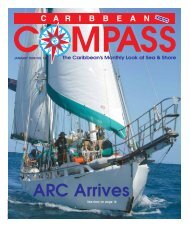TRADITIONAL LAUNCHINg - Caribbean Compass
TRADITIONAL LAUNCHINg - Caribbean Compass
TRADITIONAL LAUNCHINg - Caribbean Compass
You also want an ePaper? Increase the reach of your titles
YUMPU automatically turns print PDFs into web optimized ePapers that Google loves.
ADVENTURE’S WIFE<br />
Mary’s Voyage. by Mary Caldwell and Matthew M.<br />
Douglas. Sheridan House, © 2008, Paperback.<br />
ISBN: 978-1-57409-7.<br />
Mary Caldwell is the widow of adventurer John<br />
Caldwell who died in St. Vincent in 1998. Mary’s<br />
Voyage is less an autobiography, as the title suggests,<br />
than a memoir of her years with the sailor, author, and<br />
hotelier known in the Lesser Antilles as “Johnny<br />
Coconut.” And the book really is the story of John as<br />
recalled by Mary and told by a co-author who writes on<br />
her behalf.<br />
John Caldwell, who died at age 76, was a legend in<br />
his own time. How much of a legend he is today I don’t<br />
know. It seems probable he is remembered only by the<br />
old hands in the islands who knew him or knew of<br />
him, and there are fewer and fewer of them every year.<br />
But one thing will live a long time, as it already has,<br />
and that is his first book, Desperate Voyage.<br />
Published in the US in 1949, the book made him a<br />
sailor-celebrity. The narrative recounts an epic solo<br />
sail across the South Pacific in Pagan, a 27-foot wooden<br />
cutter. Caldwell had served in the US Merchant<br />
Marine in the early years of the Second World War,<br />
traveling through the Far East, but he knew nothing<br />
about sailing when he departed Panama, bound for<br />
Australia and his wife — Mary. They had met in 1944<br />
while serving in the Australian Air Force, and were<br />
married before the war ended. John, after rejoining the<br />
merchant marine, returned to the States to be discharged<br />
in 1946, while Mary remained in her homeland.<br />
So what there was structurally was a kind of<br />
modern Odysseus trying to get home to Penelope.<br />
Like Odysseus, Caldwell faced countless trials,<br />
which culminated in a storm that left Pagan dismasted.<br />
Caldwell drifted under a jury-rig and without water<br />
or food for 49 days, before the hull struck a reef and<br />
he was washed ashore hanging onto a spar. On<br />
Tuvutha, a remote island in the Fijis, he was nursed<br />
back to health. It is his account of his survival that<br />
makes the book one that has never been out of print<br />
and has been translated into a dozen languages.<br />
In time, the Caldwells settled in southern California<br />
and started a family. John returned to college and took<br />
a job as a social worker. But their dream was to sail<br />
away and so, not without the help of royalties from his<br />
book, they bought Tropic Seas, a 36-foot Tahiti ketch.<br />
Beginning in 1952, they sailed to Australia for two years,<br />
and along the way, in Tahiti, had their third son.<br />
Settling in Australia, they found jobs and after a<br />
time built the 46-foot ketch Outward Bound, a Francis<br />
Herreshoff design. In 1958, they continued their westward<br />
wandering. John had written a second book,<br />
Family at Sea (1956), about their Pacific crossing, and<br />
the proceeds from that helped finance the voyage that<br />
took them across the Indian and Atlantic oceans.<br />
Like countless others, on reaching the Lesser Antilles<br />
they ran out of money and got in the chartering game.<br />
For the next five years, working out of English Harbor,<br />
they chartered Outward Bound up and down the<br />
islands. Caldwell started to plant coconuts everywhere<br />
he went and, with the stern of the ketch looking with<br />
its seedlings something like the Bounty with breadfruit,<br />
this was how he first went ashore on a barren,<br />
mosquito-ridden swamp of an islet in the Grenadines<br />
called Prune.<br />
Caldwell, having had a kind of vision, talked the<br />
BOOK REVIEW BY RICHARD DEY<br />
government into letting him lease the islet for 99 years<br />
for one dollar. With no relevant experience and no<br />
money to speak of, he went to work. With Mary, his<br />
two sons, and workers from Union Island, he transformed<br />
the swamp into Palm Island, the beach club<br />
and residential community. If The Odyssey was the<br />
prototype for Desperate Voyage, Herman Wouk’s Don’t<br />
Stop the Carnival (1965) was a model for the Palm<br />
Island development.<br />
After opening for Christmas 1967, the resort had its<br />
ups and downs but it was successful, in part because<br />
readers of Desperate Voyage came from as far away<br />
as Russia just to meet the author. Upon John’s<br />
death, Mary sold out and Palm exists today under<br />
different ownership.<br />
We don’t learn much about John’s wife in Mary’s<br />
Voyage, really. She casts herself as a long-suffering<br />
but strong “seawife,” an anxious mother, an antiintellectual,<br />
and a full-time companion in John’s<br />
adventuring. Mary took her turns on watch even as<br />
she oversaw the boys’ schoolwork. She suffered chronic<br />
seasickness even as she cooked and cleaned. Later,<br />
in the charterboat phase, she did the bookkeeping,<br />
cooking, and other chores while John did the sailing<br />
and regaling. On Palm, she helped in every way, and<br />
designed the original beach club buildings. Through<br />
most of the account, this is what you get. John was<br />
the dominant personality, the indomitable spirit, and<br />
the voyage was his; she was along for the ride. She had<br />
been preceded by women like Gwen Tompkins and Exy<br />
Johnson, who brought up children at sea with their<br />
adventurous husbands.<br />
Left to her own devices, Mary’s Voyage would not<br />
likely exist. John’s first two books covered their early<br />
years, many others covered chartering in the 1960s,<br />
and plenty of press was given to Palm Island. However,<br />
there has been the idea of turning Desperate Voyage<br />
into a movie for decades. The problem was that the<br />
narrative of a single man’s survival at sea, no matter<br />
how astounding, was unpromising movie material.<br />
Matthew M. Douglas, the co-writer, is advertised on<br />
the book’s back cover as having written a screenplay<br />
based on Desperate Voyage. (He is, according to<br />
Google, the author of one book, The Lives of Butterflies,<br />
a natural-history book published by a university press<br />
in 1987.) Mary’s Voyage reads like a prose draft for a<br />
screenplay, for in Douglas’s telling, Desperate Voyage<br />
is alluded to all along the storyline until, toward the<br />
end, we are given the account of John’s epic voyage,<br />
enhanced not only by his final visit to the Fijis but by<br />
an account of his unhappy childhood — which, perhaps,<br />
explains it all.<br />
Well, it could work — a movie based on the long arc<br />
of the Caldwells’ journey, with Desperate Voyage presented<br />
as something recalled in dialogue and flashbacks.<br />
But Mary’s Voyage is, as a book, flawed.<br />
Chiefly, there is no character development or change,<br />
and no conflict among the characters. Late in the book<br />
we learn all was not well with the Caldwell family, nor<br />
with the larger Palm Island family, but by then the<br />
sentimental narrative has pretty much lulled you into<br />
reverie. The narrative itself is thick with cliché (“teeth<br />
of the storm”) and sudsy, formulaic dialogue.<br />
Copyediting errors jar both with fact (Douglas Terman,<br />
not Doug Therman, wrote thrillers not mystery tales)<br />
and nautical usage (“ Like all ketches, she sported two<br />
raked masts… The smaller sails on a ketch are easier<br />
to handle than the large sheets of a sloop.”) An important<br />
final chapter is called “Secrets of Desperate<br />
Voyage Revealed” (sic), but it turns out there are no<br />
secrets — the story is all in John’s own book. Further,<br />
certain important details of motivation and their personal<br />
lives are left out. And the underlying sensibility,<br />
surprisingly, is rooted less in Third World realities<br />
than in neo-colonial notions of “paradise.”<br />
John Caldwell was an unusual man, a contradictory<br />
man. He was the personification of the anti-establishment,<br />
independent spirit that went to sea to escape<br />
dull routine and seek adventure. He wanted that and<br />
he wanted a family too. And then he wanted his own<br />
island, his own “paradise.” A driven, goal-oriented<br />
man, he was a ferocious worker in an islandscape<br />
considered idyllic. He was also something of a socialist<br />
in an upscale capitalist environment. He was a man on<br />
the margins of the world when there were still margins<br />
— unspoiled coral reefs and pristine island beaches,<br />
all open and free for the taking; unpolluted seas,<br />
uncrowded anchorages, and peoples still unaffected by<br />
Western industrial society. The experiences of John<br />
and Mary Caldwell simply cannot be replicated today,<br />
and we are the richer for their remembrances.<br />
Available at bookstores or at www.sheridanhouse.com.<br />
Stock Up<br />
on the widest selection and the<br />
best prices in Grenada at our two<br />
conveniently located supermarkets.<br />
Whether it’s canned goods, dairy<br />
products, meat, fresh vegetables<br />
or fruits, toiletries, household goods,<br />
or a fine selection of liquor and wine,<br />
The Food Fair has it all and a lot more.<br />
Hubbard’s<br />
JONAS BROWNE & HUBBARD (G’da.) Ltd.<br />
The Carenage:<br />
Monday - Thursday<br />
8 am to 5:30 pm<br />
Friday until 8:45 pm<br />
Saturday until<br />
1:00 pm<br />
Tel: (473) 440-2588<br />
Grand Anse:<br />
Monday - Thursday<br />
9 am to 5:30 pm<br />
Friday & Saturday<br />
until 7:00 pm<br />
Tel: (473) 444-4573<br />
STREET’S GUIDES<br />
ARE MORE ECONOMICAL!<br />
Written by an author with 50 years of sailing<br />
experience in the <strong>Caribbean</strong>, the series’ four volumes<br />
cover the Eastern <strong>Caribbean</strong> from Puerto Rico<br />
down through the islands and<br />
the coast of Venezuela to the ABCs.<br />
REAL SAILORS<br />
BUY STREET’S GUIDES<br />
Real sailors use Street’s Guides for inter-island and harbor<br />
piloting directions, plus interesting anecdotes of people,<br />
places and history. Street’s Guides are the only ones that<br />
describe ALL the anchorages in the Eastern <strong>Caribbean</strong>.<br />
NEW! Street’s videos, first made in 1985,<br />
are now back as DVDs.<br />
• “Transatlantic with Street” documents a sailing passage<br />
from Ireland to Antigua via the Cape Verdes. 2 hours<br />
• “Antigua Week ’85” is the story of the engineless yawl Iolaire<br />
racing round the buoys to celebrate her 80th birthday. 1 hour<br />
• “Street on Knots” demonstrates the essential knots and<br />
line-handling skills every sailor should know. 1 hour<br />
All are available via Armchair Sailor and Bluewater Books.<br />
HURRICANE TIPS! Visit www.street-iolaire.com for a wealth of<br />
information on tracking and securing for a storm.<br />
Street’s Guides are available<br />
at bookshops and chandleries, or from<br />
www.iUniverse.com and www.seabooks.com<br />
☛ REMEMBER<br />
to tell our advertisers you<br />
saw their ad in <strong>Compass</strong>!<br />
DECEMBER 2008 CARIBBEAN COMPASS PAGE 43


